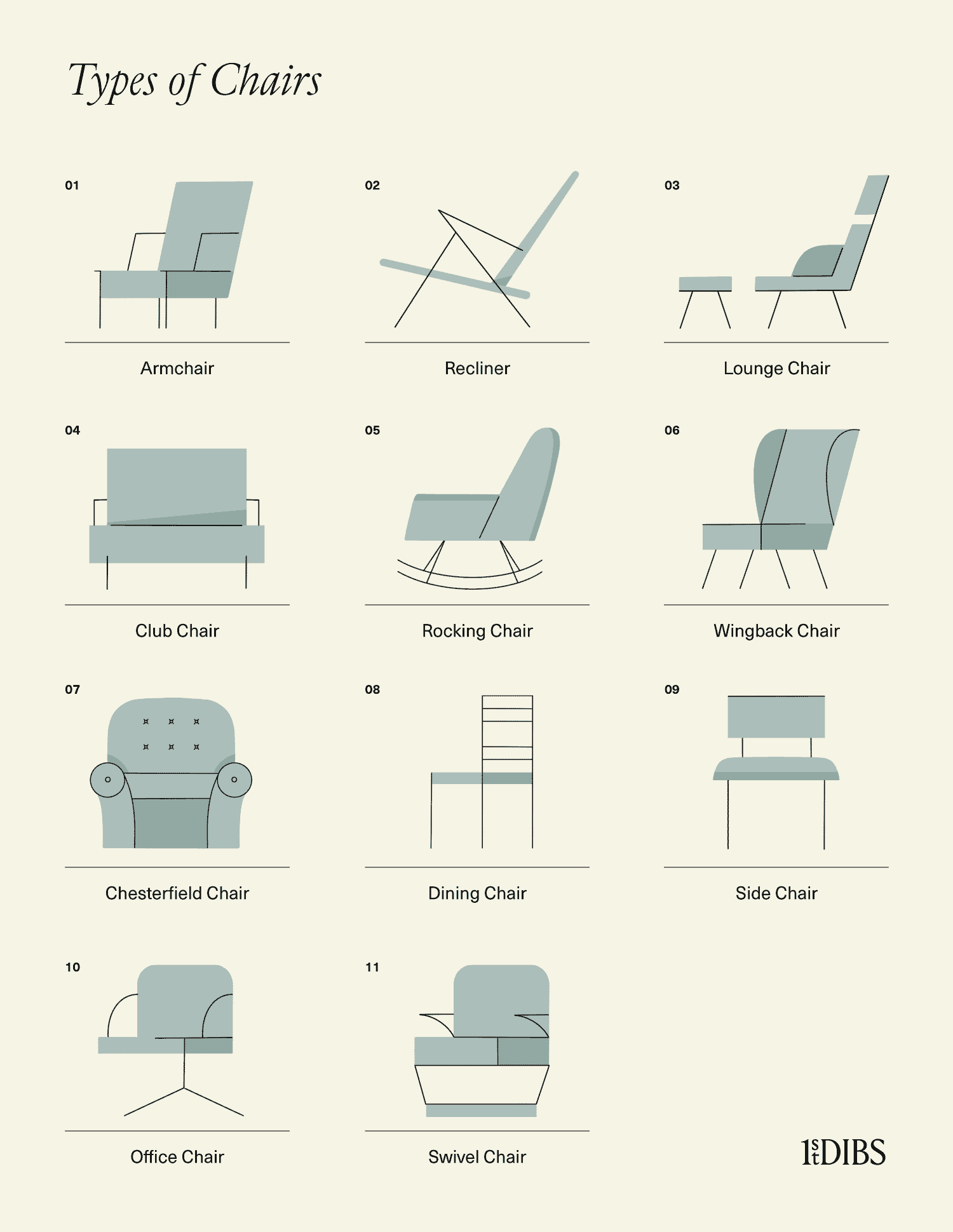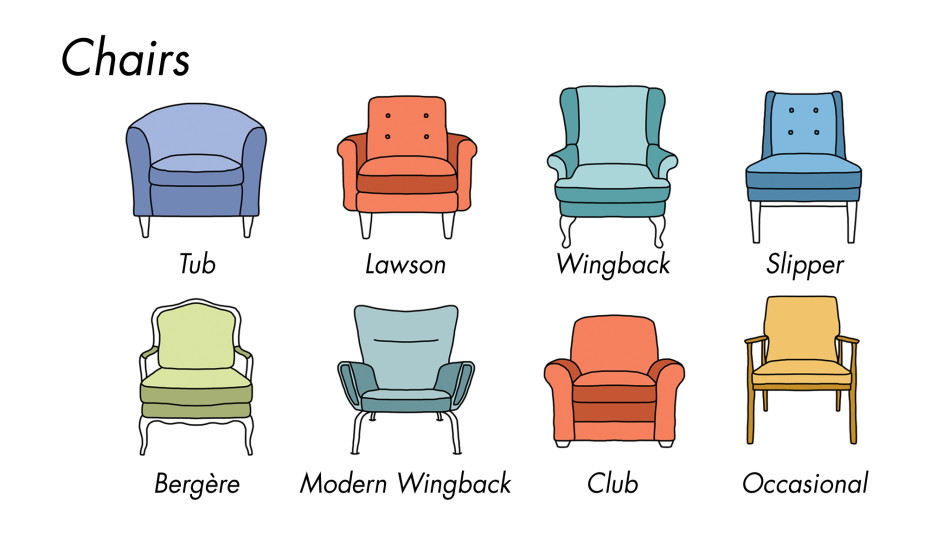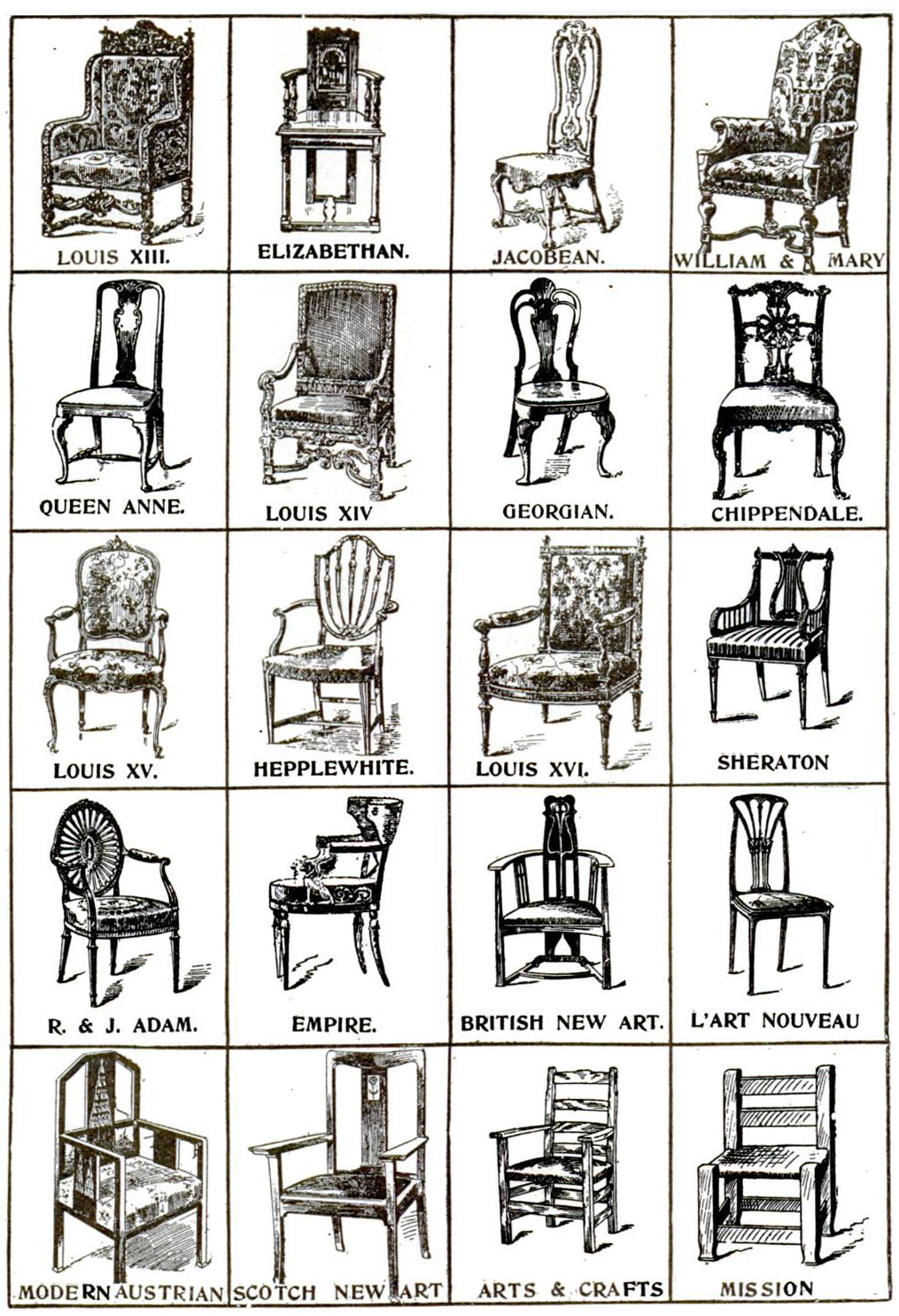
Upholstered chairs are more than just functional pieces of furniture; they are statements of style, comfort, and personality within any interior space. From grand living rooms to cozy reading nooks, the right upholstered chair can define an aesthetic, provide a focal point, and offer an inviting embrace. The vast array of styles, each with its unique history, design elements, and intended use, can be overwhelming. Understanding the distinct characteristics of popular upholstered chair styles is key to making informed design choices that reflect personal taste and enhance a room’s overall ambiance. This guide delves into the names and defining features of some of the most iconic and versatile upholstered chair styles, helping you navigate the rich tapestry of furniture design.
1. The Wingback Chair
Perhaps one of the most recognizable and enduring upholstered chair styles, the Wingback Chair, also known as a Wing Chair, dates back to the 17th century. Originally designed to shield occupants from drafts and trap the warmth of a fireplace, its defining features are the "wings" that extend from the back down to the armrests. These wings, along with a high back, create a sense of enclosure and privacy. Wingback chairs often feature rolled or flared arms, cabriole or straight legs, and are traditionally upholstered in rich fabrics like leather, velvet, or brocade. They exude a classic, stately elegance, making them perfect for traditional living rooms, studies, or as a sophisticated accent in more contemporary settings.
2. The Club Chair
The Club Chair emerged in 19th-century France, originally known as "fauteuil confortable" (comfortable armchair). Its name, "club chair," became popular due to its prevalence in gentlemen’s clubs. This style is characterized by its low profile, deep seat, and generously padded arms and back, offering exceptional comfort. Often upholstered in leather, though fabric versions are common, club chairs have a robust, masculine appeal. Their rounded or square silhouettes and sturdy construction make them ideal for creating a cozy, inviting seating area in a living room, den, or library. The Club Chair effortlessly blends comfort with a timeless, sophisticated aesthetic.
3. The Chesterfield Chair
While often associated with sofas, the Chesterfield style also applies to individual chairs, maintaining its distinctive characteristics. Originating in the 18th century, possibly commissioned by the Earl of Chesterfield, this style is instantly recognizable by its deep button tufting, rolled arms that are the same height as the back, and often a nailhead trim. Traditionally upholstered in dark leather, modern interpretations also feature velvet, linen, or other fabrics in a myriad of colors. The Chesterfield chair embodies classic British elegance and gravitas, making it a luxurious addition to traditional, eclectic, or even industrial-chic interiors, providing a sense of grandeur and history.
4. The Bergère Chair
Hailing from 18th-century France, the Bergère Chair is a sophisticated upholstered armchair with an exposed wooden frame. Its name, meaning "shepherdess," hints at its comfortable, inviting nature. Key features include a deep, wide seat, a loose seat cushion, and often a curved, enclosed back and arms that are upholstered on the inside but expose the wooden frame on the outside. The wooden frame is typically carved and can be gilded, painted, or left in its natural finish. Bergère chairs exude a refined, romantic charm, perfectly suited for elegant living rooms, bedrooms, or as a distinguished accent in a French country or traditional décor.
5. The Fauteuil Chair
Another classic French armchair from the 17th century, the Fauteuil (pronounced "foh-toy") is similar to the Bergère but distinct in its open arms. Like the Bergère, it features an exposed wooden frame, often intricately carved, and upholstered seat, back, and armrests. However, the Fauteuil’s arms are typically open, meaning the upholstered portion does not extend fully to the armrest, leaving a gap between the arm and the seat. This design lends a lighter, more delicate appearance. Fauteuil chairs are versatile, fitting seamlessly into formal living rooms, studies, or as elegant dining chairs, bringing a touch of refined European sophistication.
6. The Slipper Chair
The Slipper Chair gained popularity in the early 20th century, particularly in women’s bedrooms and dressing rooms. Its defining characteristic is its armless design and low-to-the-ground profile, making it easy to sit down and put on or take off slippers – hence the name. Slipper chairs often have a slightly reclined back and a compact footprint, making them ideal for smaller spaces or as accent chairs. They can be fully upholstered, often featuring interesting patterns or textures. This style offers a chic, minimalist elegance, perfect for bedrooms, entryways, or as additional seating in a living room without obstructing views.
7. The Barrel Chair
The Barrel Chair, also known as a Tub Chair, emerged in the late 19th century and gained significant popularity in the mid-20th century. Its name is derived from its distinctive shape: a rounded, continuous back that curves around to form the arms, resembling a cut-in-half barrel. This seamless, enveloping design provides a cozy and supportive seating experience. Barrel chairs are typically fully upholstered, often with a loose seat cushion, and sit on short, sturdy legs. Their compact, curvilinear form makes them versatile for various settings, from living rooms and offices to lobbies, offering a blend of comfort and modern, sculptural appeal.
8. Mid-Century Modern Lounge Chairs
The mid-20th century (roughly 1933-1965) was a period of revolutionary design, giving rise to iconic upholstered lounge chairs that prioritize form, function, and innovative materials. While diverse, these chairs often share characteristics like clean lines, organic shapes, and a blend of materials such as wood, metal, and upholstery.
- The Egg Chair (Arne Jacobsen, 1958): Known for its sculptural, curvilinear shell that cradles the sitter, often upholstered in vibrant fabrics or leather, mounted on a swivel base.
- The Swan Chair (Arne Jacobsen, 1958): A softer, more fluid counterpart to the Egg, with no straight lines, designed for lobbies and lounge areas.
- The Eames Lounge Chair (Charles and Ray Eames, 1956): While famously leather, its upholstered counterpart forms are also significant. It’s a prime example of luxurious comfort combined with modern design, featuring molded plywood shells and plush cushions.
These chairs are statements of art and comfort, ideal for contemporary, minimalist, or retro-inspired interiors.
9. The Tufted Chair
While "tufted" describes a technique rather than a specific chair style, it’s so defining that it often characterizes the aesthetic of many upholstered chairs. Tufting involves pulling fabric through the upholstery and securing it with a button or knot, creating depressions and folds that add depth, texture, and a luxurious feel. It can be deep-buttoned (like the Chesterfield), channel tufted (rows of vertical or horizontal folds), or biscuit tufted (square or rectangular tufts). Tufting is found on styles ranging from Victorian and Art Deco chairs to modern designs, adding a touch of elegance, sophistication, and visual interest, often associated with high-end or classic furniture.
10. The Occasional/Accent Chair
"Occasional chair" and "accent chair" are broad categories for chairs that are not part of a primary seating arrangement but serve as standalone pieces to add visual interest, provide extra seating when needed, or fill an empty corner. These chairs are often chosen for their aesthetic appeal, unique design, or ability to complement the existing décor. They can encompass a wide range of styles, from vintage finds to contemporary designs, often featuring bold patterns, unique shapes, or luxurious upholstery. An occasional chair is a versatile tool for interior designers, allowing for pops of color, texture, or an unexpected design element in any room.
11. The Chaise Lounge
The Chaise Lounge (French for "long chair") is a hybrid piece, essentially an elongated chair designed for reclining. Dating back to ancient Egypt and popularized in 18th-century France, it typically features an upholstered backrest and an extended seat long enough to support the legs. Some designs have a single armrest, while others are armless or have two arms. Chaise lounges are synonymous with relaxation and luxury, often found in bedrooms, sunrooms, or large living areas. They offer a sophisticated alternative to a sofa or armchair, providing a comfortable spot for reading, napping, or simply lounging in style.
12. The English Roll Arm Chair
A quintessential symbol of comfort and timeless elegance, the English Roll Arm Chair is characterized by its low, generously rolled arms, a deep seat, and often a loose back cushion. Developed in England in the 19th century, it prioritizes comfort and a relaxed aesthetic. These chairs are typically fully upholstered, often with a skirted base, and feature soft, inviting cushions. The English Roll Arm Chair fits seamlessly into traditional, country, or transitional interiors, offering a cozy and welcoming presence. Its enduring appeal lies in its ability to combine classic lines with unparalleled comfort, making it a beloved choice for family living spaces.
13. The Lawson Style Chair
The Lawson Style Chair, named after American millionaire Thomas W. Lawson who commissioned its design for comfort in the early 20th century, is known for its simple, clean lines and emphasis on comfort. Its defining features include setback arms that are lower than the back, and loose, plush seat and back cushions. Unlike the rolled arms of English styles, Lawson arms are typically straight or gently curved, giving it a more contemporary and less formal appearance. This style is incredibly versatile, fitting well into modern, transitional, and casual interiors, providing a comfortable and unfussy seating option that can be easily customized with various fabrics.
In conclusion, the world of upholstered chair styles is rich and diverse, offering an option for every taste, need, and interior design vision. From the regal presence of a Wingback to the minimalist chic of a Slipper chair, each style tells a story of its origins and offers a unique blend of form and function. Understanding these distinct names and their defining characteristics empowers you to select pieces that not only provide comfort but also serve as integral elements in crafting a cohesive and inviting living space. The right upholstered chair is more than just furniture; it’s an investment in comfort, style, and the very character of your home.






